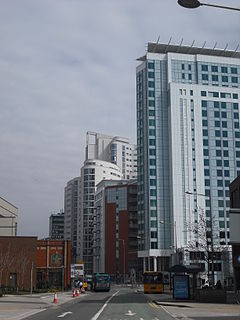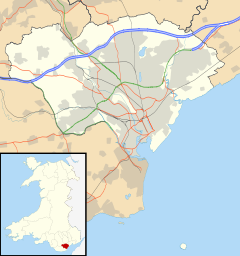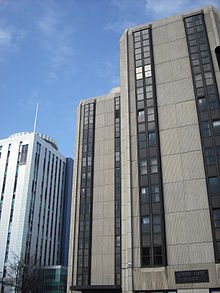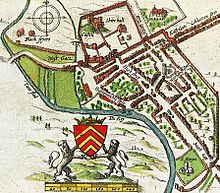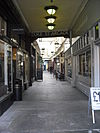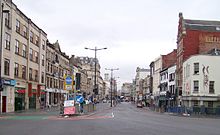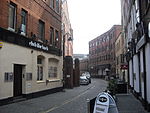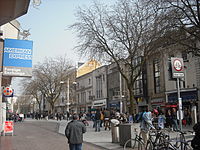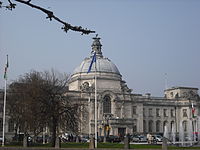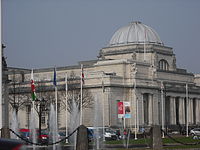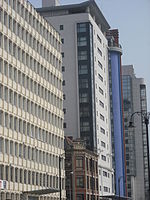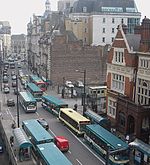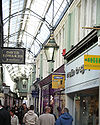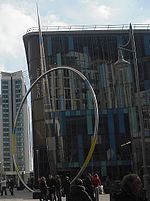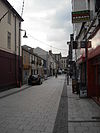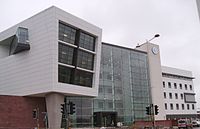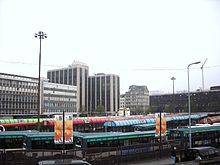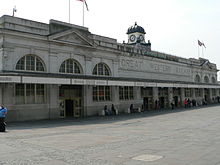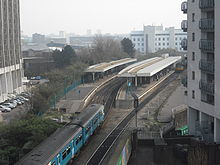- Cardiff city centre
-
Coordinates: 51°29′N 3°10′W / 51.48°N 3.17°W
Cardiff City Centre Welsh: Canol Y Ddinas Caerdydd
Altolusso residential tower (left) and Meridian Gate (right)
 Cardiff City Centre shown within Cardiff
Cardiff City Centre shown within CardiffPrincipal area Cardiff Ceremonial county Cardiff Country Wales Sovereign state United Kingdom Post town CARDIFF Postcode district CF10; CF11; CF24 Dialling code 029 Police South Wales Fire South Wales Ambulance Welsh EU Parliament Wales UK Parliament Cardiff Central Welsh Assembly Cardiff Central List of places: UK • Wales • Cardiff Cardiff city centre (Welsh: Canol Dinas Caerdydd) is the central business district of Cardiff, Wales. The area is tightly bounded by the River Taff to the west, the Civic centre to the north and railway lines and two railway stations - Central and Queen Street - to the south and east respectively. Cardiff became a city in 1905.
The city centre in Cardiff consists of principal shopping streets, Queen Street and St. Mary's Street, large shopping centres, and numerous arcades and lanes that house some more smaller and often specialist shops and boutiques.
The city centre is going through a number of redevelopment projects, including St. David's 2, which extended the shopping district southwards, creating 100 new stores and a flagship John Lewis, the only branch in Wales and the largest outside London. Compared to nearby cities, the new St David's Centre has more retail space than the whole of Newport or Swansea.[citation needed]
In 2008–9, the annual footfall of shoppers was 55 million, and is expected to have risen to 66 million by 2009–10.[1] Cardiff is the sixth most successful shopping destination in the United Kingdom – behind London, Glasgow, Birmingham, Manchester and Liverpool.[2]
Contents
History
Cardiff was granted city status by King Edward VII in 1905.[3]
In the 1960s, planners described Cardiff city centre as "worn out, inconvenient, drab and dangerous". The centre had escaped the extensive wartime bomb damage inflicted on other cities, so little redevelopment took place in the 1950s and 1960s. The Buchanan Plan of 1964 envisaged a highly-ambitious extended city centre, crossed with urban motorways. The council scrapped the proposed motorway network and focused on the small commercial core of the city; its proposed redevelopment scheme, in partnership with a private developer, would have seen almost all of the city centre (except St Mary Street and Working Street) demolished, replaced by modernist office towers of up to 21 storeys and pedestrianised decks linking multi-storey car parks to covered shopping malls.[4]
By the time the legal agreement to implement 'Centreplan 70' was signed, the 1973 property crash had made it unviable. However, one legacy of the scheme was the future segregation of office and retail development, with the west end of Newport Road as the principal office area with secondary concentrations on Churchill Way, Greyfriars Road and Westgate Street.[4]
Development in the 1970s and 80s was more piecemeal than envisaged in Centreplan, with the building of the St. David's Centre and St David's Hall, new multi-storey car parks, and the grant-supported construction of 14-storey Holiday Inn (now the Marriott) and World Trade Centre (now the Cardiff International Arena), which gave a fillip to the city's conference and exhibition business. In the mid-1980s developers returned to Queen Street, creating three medium-sized malls, helping it to become one of the best performing shopping streets in the country in terms of footfall and rental levels.[4]
In the 1990s the Mill Lane cafe quarter was developed in partnership with the Welsh Development Agency, a pedestrian forecourt was created for the refurbished Central railway station, a new walkway was constructed alongside the Taff and the Millennium Stadium was built on the site of the National Ground and Empire Pool. The latter became, according to official publicists, one of the icons of Cardiff's new image.[4]
Castle Quarter
The Castle Quarter includes some of Cardiff's Victorian and Edwardian arcades: Castle Arcade, High Street Arcade and Duke Street Arcade, and principal shopping streets: St Mary Street, High Street, Castle Street and Duke Street.
Development of the area began in February 2010 and is expected to be completed by July 2011. Cardiff Council says that work to create the Castle Quarter as a pedestrian friendly environment for High Street and St Mary Street is designed to enhance the city centre.[5]
Castle Street/Duke Street/Kingsway
Castle Street follows on from Cowbridge Road East from Canton and begins after Cardiff Bridge, over the River Taff. It becomes Duke Street after the junction with High Street before turning north and becoming Kingsway, leading to Cardiff Civic Centre. From west to east, streets that begin from the southern side of this stretch are Westgate Street, Womanby Street, High Street (St Marys Street), St Johns Street (The Hayes), Queen Street and Greyfriars Road. Cardiff Castle and Bute Park dominate the northern side of the street. On the southern side are pubs, bars, retail and hotel units. Castle Arcade and Duke Street Arcades begin from this stretch.
St. Mary Street and High Street
Main article: St. Mary Street/High StreetSt. Mary Street (Welsh: Heol Eglwys Mair) and High Street (Welsh: Heol Fawr). The former street is named after the 11th century church of St. Mary, the largest in Cardiff until it was destroyed by the Bristol Channel floods of 1607. Today the stretch of road is the home of a number of bars, night clubs and restaurants, as well as branches of many major banks. Also fronting onto the street is Howells department store, which stretches from just after Cardiff Central Market to the corner of Wharton Street. From August 2007 the street was closed to private vehicles, leaving only buses, cycles and taxis allowed to access the whole street.[citation needed] The street is usually closed to all traffic every Friday and Saturday night to allow the efflux from night clubs and pubs located in that part of the street to clear. It is also closed when major events take place such as at the Millennium Stadium.[6] The Prince Of Wales is a prominent J D Wetherspoon establishment at the junction with Wood Street, which leads to Central Station. At the northern end of the street is Castle Street and Cardiff Castle. To the south is Callaghan Square.
Womanby Street
Womanby Street is one of Cardiff's oldest streets. It is home to the well known nightclub and music venue Clwb Ifor Bach. It is accessed from Castle Street, in between Westgate Street and High Street.
Queen Street and vicinity
Queen Street (Welsh: Heol y Frenhines) is the main thoroughfare in the city, now wholly pedestrianised. Most of Queen Street, from the castle moat to Dumfries Place, used to be called Crockherbtown (Crockherbtown Lane can still be found off Park Place),[7] but the street was renamed in honour of Queen Victoria in 1886.[8] Queen Street was pedestrianised in 1974 and is served by Cardiff Queen Street railway station on Station Terrace. It meets Dumfries Place/Newport Road at its eastern end, Duke Street/Castle Street at its western, and Park Place approximately half-way along. Further down Park Place is the New Theatre, a local landmark is Principality House, head office of the Principality Building Society.[9][not in citation given] To the north running parallel is Greyfriars Road, referring to the site of an old monastery, a traditional office location that has recently seen conversion to bars, apartments and hotels as offices move to the new business parks on the edge of the city, or to the better connected southern end of the city centre.
Cathays Park (Civic Centre)
Cathays Park is the civic centre of Cardiff. The Edwardian architecture of Cardiff City Hall, National Museum and Gallery of Wales, Cardiff University, Cardiff Crown Court, and the administrative headquarters of the Welsh Assembly Government dominate the area. .Behind the City Hall is the Welsh National War Memorial. Bute Park also dominates the north-west of the area, running behind Cardiff Castle along the River Taff southward to Westgate Street and northward to Gabalfa. Cardiff's Winter Wonderland ice rink and fairground returns to the front lawn of the City Hall every winter.[10]
Boulevard de Nantes and Stuttgarter Strasse, named after Cardiff's twin cities, run through the southern end and act as a northern bypass of parallel Queen Street for the A4161. To the west, it is connected to Kingsway (leading to Castle Street and St Mary Street), and Dumfries Place/ Newport Road to the east. Park Place runs north to south through the area, linking it to the A470 in the north and Queen Street in the south
Eastern city centre
Dumfries Place/Newport Road
Dumfries Place is named after the Earl of Dumfries, a courtesy title given to the Marquis of Bute's eldest son.
This major road leading east from Queen Street towards the neighbouring city of Newport has been one of the prime office locations of central Cardiff since the 1960s. Some of the original buildings have recently been converted from office use to residential (e.g. The Aspect, Admiral House[11][not in citation given]) or hotel use including the Mercure Holland House. Occupancy of the remaining commercial property has increased, reflecting a shortage of office space in the city and there is now little scope for further conversion. Newport Road is also home to several buildings owned by Cardiff University, and Shand House, occupied by Cardiff Institute for the Blind.
Newport Road is also the site for the Cardiff Royal Infirmary, now providing long term care and rehabilitation. The hospital once housed 500 beds and provided the main A&E service for Cardiff before the University Hospital of Wales took over these functions.
Churchill Way
Churchill Way runs parallel to the west of Station Terrace (Cardiff Queen Street station) and joins Queen Street in the north and Bute Terrace in the south. The Capitol Centre is on the corner with Queen Street. Further along this road are office and modern apartment developments. The Cardiff office of the Driving Standards Agency, former British Gas offices in Helmont House, and an Ibis Hotel are located on this street.[12][not in citation given][13][not in citation given][14][unreliable source?] Cardiff Masonic Hall occupies a major site on the corner of Guildford Street, adjacent to Chrurchill Way
South-western city centre
Wood Street
Wood Street is the main access point for Cardiff Central railway and Central bus stations, with the latter undergoing reconstruction since early 2008. The street also has bus stands running along the length of the street as well and allows access to the. Travelling westwards along this street are the Millennium Stadium, Millenium Plaza (with bars, night clubs, comedy clubs and a Vue cinema), Stadium House, Media Wales (offices of the South Wales Echo and Western Mail) and Southgate House, (which houses among other organisations the Cardiff offices for the Armed Forces).
Westgate Street
Westgate Street runs parallel just west of St Marys Street for about half of the latter's length, linked by several alleys and lanes. Linking Castle Street and Wood Street, Cardiff Arms Park and the Millennium Stadium dominate its western side, whereas hotels, pubs and bars dominate its eastern side.
The Hayes
The Hayes (Welsh: Yr Aes) is where the department store Howells, Spillers Records, St David's Hall and elegant Victorian arcades are found. The Hayes used to be home to David Morgan department store, a historic local landmark. Since its closure in 2005, the Grade I listed David Morgan Buildings have been subdivided into several retail units, and the upper floors converted into 56 luxury apartments. The exterior of the building received a comprehensive refurbishment, with the facade being restored to its original design following many alterations since its construction in the late 1800s.
The eastern side of the Hayes is fronted by the new St. Davids shopping centre. Prior to this it was home to Oxford Arcade, a post war construction that dated quickly and was underused given its central location. This area also features the new Cardiff Central Library which opened in March 2009. The previous Central Library closed in 2006 for the construction of the St. David's shopping centre and was located a few hundred yards north.
As part of the St Davids development, the Hayes has be pedestrianised and repaved, and a new public square was be created at its southern end with large, interactive public artwork as its centrepiece including Alliance, a 25 metres (82 ft) high sculpture consisting of a large stainless steel and enamelled metal arrow column and a hoop, which glows in the dark, and falls and rises with the tide.
Caroline Street
Caroline Street is a pedestrianised link between St Mary Street and The Hayes. The street has been a host to all kinds of stores but has seen a surge in chip and kebab shops, and as such is commonly known as Chippy Lane.[15][not in citation given] Around 2003, the north side of the street was redeveloped after the demolition of the old Brains Brewery. In its place were luxury flats encircling the Old Brewery Quarter, where new shops, bars and restaurants were erected. The pavement on the street was re-tiled as part of this development.
South-eastern city centre
Callaghan Square
This development, built in 1999, extends the central business district south of the mainline railway. Eventually the main development will include approximately 850,000 square feet (77,000 m²) of office space and other uses, of which approximately 350,000 square feet (33,000 m²) is complete (with the largest occupiers being Eversheds and British Gas). Further phases are unlikely to be built on a speculative basis. The initial masterplan suggest that the final phase, yet to be commenced, will also include hotel and residential use. Nearby offices on Tresillian Way (housing The AA, and Lloyds TSB Black Horse finance amongst others) plus further potential developments have turned the area relatively quickly into one of the largest office locations in Central Cardiff. Within a few years total office space in the area will exceed 1 million square feet (90,000 m²).
Custom House Street/Bute Terrace/Adam Street
These two roads have traditionally formed the southern and south-eastern boundaries of the central business district of Cardiff, and in recent years have seen a great deal of new development with much due in the next few years. Recent developments such as the 23 story Altolusso apartment complex, and the Big Sleep Hotel are set to be joined by (from west to east), a new 11 story office building (on the site of the old Central Hotel - destroyed by fire in the early 2000s); the Meridian Gate development (consisting of 11-story apartment block and a 21-story Radisson SAS Hotel); a new John Lewis department store as part of the St. David's 2 shopping expansion; Harlech Court (consisting of apartments and a rooftop restaurant); the University of Glamorgan's new ATRiuM campus (which opened in 2007) along with the 21-story Tŷ Pont Haearn student halls; and 3 further residential towers (of up to 13 stories) with lower floor retail and commercial use.
Access
From the north, North Road (A470) meets the city centre at the junction with Castle Street and Boulevard de Nantes, with the latter route forming a northern and eastern by-pass, meeting Newport Road (A4161) and then Callaghan Square, just south of the city centre.
From the west, the centre is accessed from Castle Street (A4161), Wood Street and Penarth Road (A4160), with St. Mary's Street connecting the three, but is restricted to no-car traffic. Penarth Road terminates at Callaghan Square.
From the south, Lloyd George Avenue (A470), Bute Street and the Central Link (A4234) originate from Cardiff Bay and meet the city centre at Callaghan Square.
Transport in the city centre
Bus
The vast majority Cardiff Bus services run to or through the city centre, approaching from the west along either Tudor Street or Westgate Street, from the north along North Road or Newport Road, from the east along Newport Road and from the south along Callaghan Square. Most services circle the city centre, creating a "bus box". Some terminate or pass through Cardiff Central bus station, off Wood Street, which is currently being redeveloped. Other major interchanges include The Hayes, Dumfries Place, Westgate Street, Greyfriars Road and St. Mary Street, with taxi stands being located next to most of these.
Cardiff Bus operates the Free b service, a free shuttle bus that circles the city centre every 10 minutes, linking major bus and rail interchanges, as well as the stops of the four Park and Ride services. The Baycar service also circles the city centre every 10 minutes before continuing to Cardiff Bay.
Rail
The city centre is served by two railway stations. Cardiff Queen Street is in the east of the centre and is the city's main hub for urban services to the rest of Cardiff, its valleys and the Vale of Glamorgan. Cardiff Central, located in the south of the city centre, is largest station in the city and one of the busiest in the United Kingdom, focusing on mainline services. Central railway station is located next to Central bus station forming an interchange.
Cathays railway station, Grangetown railway station and Ninian Park railway station are all within 1.5 miles (2.4 km) of the centre serving edges of the city centre.
Road
The A470 bypasses the centre to the east running southbound to Cardiff Bay and northbound to North Cardiff, Pontypridd, Merthyr Tydfil and Brecon. The A470 road meets the A4232 at Cardiff Bay, leading to Culverhouse Cross and the M4 motorway, and also meets the A48 Camarthen-Gloucester road at Gabalfa, north of the centre. Some city centre taxis can be hailed. They are usually, but not always, black with a white bonnet or hackney carriages.
Water
The Cardiff Waterbus has stops at Cardiff Castle and Taff Mead Embankment, next to the Millennium Stadium, with services to Cardiff Bay.
Cycle
A cycle hire system, similar to those in other large cities, launched in September 2009, and includes 70 bikes and 35 hire points (initially 7) around the centre and the south of the city. The current stations are: Central Station; Cardiff Bay Station; County Hall; Cardiff Bay Visitors’ Centre; Churchill Way; City Hall and eastern Queen Street. It is necessary to register before using bike. The first half an hour is free after which a small hourly fee is payable.[16][17]
Media
-
Cardiff Central Market near The Hayes
-
Cardiff Central Library at The Hayes
-
The Millennium Stadium from Wood Street
-
View of Wood Street looking north from Cardiff Central railway station with parts of the redeveloping Cardiff Central bus station in the foreground
See also
- List of tallest buildings in Cardiff
References
- ^ "'WalesOnline - News - Cardiff News -Shoppers numbers set to soar in Cardiff". WalesOnline website (Welsh Media Ltd). 2009-06-03. http://www.walesonline.co.uk/news/cardiff-news/2009/06/03/shoppers-numbers-set-to-soar-in-cardiff-91466-23774599/. Retrieved 2010-01-22.
- ^ "'WalesOnline - Business - Business News -Capital investment pushes Cardiff up retail rankings". WalesOnline website (Welsh Media Ltd). 2009-11-25. http://www.walesonline.co.uk/business-in-wales/business-news/2009/11/25/capital-investment-pushes-cardiff-up-retail-rankings-91466-25245234/. Retrieved 2010-01-22.
- ^ London Gazette Issue 27849, October 31, 1905, p.7248/9 Retrieved 2011-10-24
- ^ a b c d Hooper, A. and Punter, J., eds (2007) Capital Cardiff 1975-2020. Regeneration, Competitiveness and the Urban Environment. Cardiff: University of Wales Press.
- ^ BBC News | Cardiff shops seek compensation for roadworks
- ^ http://www.cardiff.gov.uk/content.asp?nav=2865,2870,4048,4188,5137&parent_directory_id=2865&id=5318#0
- ^ http://www.keytothecity.co.uk/dayout.htm
- ^ http://www.peterfinch.co.uk/charles.htm
- ^ http://www.principality.co.uk/default.aspx?page=64
- ^ http://www.cardiff.gov.uk/content.asp?nav=2868%2C2964%2C4981&parent_directory_id=2865
- ^ http://www.maverickpropertymanagement.co.uk/admiral_house_cardiff.htm Admiral House, Cardiff
- ^ http://www.dsa.gov.uk/AddressDetails_Bannered.asp?id=2666&Cat=-1&Type=18&ShowRoute=0
- ^ http://maps.google.co.uk/maps?hl=en&rlz=1T4GGLL_en-GB&um=1&ie=UTF-8&q=british+gas+cardiff&fb=1&split=1&gl=uk&cid=0,0,6778278633959280020&ei=Lj_nSeDaMMiB_AaZj_HmAw&sa=X&oi=local_result&ct=image&resnum=1
- ^ http://www.weddingmapper.com/plan/vendor/wales/cardiff/hotels/ibis_hotel/10092
- ^ http://www.cardiffwalesmap.com/CarolineStreet.htm
- ^ "Public bike hire scheme for city". BBC News. 2009-09-22. http://news.bbc.co.uk/2/hi/uk_news/wales/south_east/8267199.stm. Retrieved 2010-04-28.
- ^ http://www.walesonline.co.uk/news/cardiff-news/2009/09/22/smart-bike-system-launch-91466-24747392/
External links
Pontcanna Cathays Roath Riverside City centre Adamsdown Grangetown Butetown Splott City of Cardiff About Cardiff 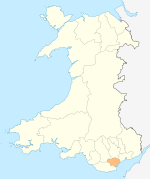
Cardiff templates North Birchgrove · Cathays · Cyncoed · Gabalfa · Heath · Lisvane · Llandaff · Llandaff North · Llanishen · Rhiwbina · Roath · Thornhill · Tongwynlais · WhitchurchWest Caerau · Canton · Creigiau · Culverhouse Cross · Danescourt · Ely · Fairwater · Pentyrch · Pontcanna · Radyr and Morganstown · St FagansSouth East Principal areas of WalesCategories:- Districts of Cardiff
- Central business districts in the United Kingdom
-
Wikimedia Foundation. 2010.

